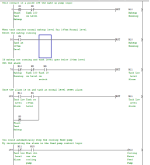Mas01
Member
I've got 4 float switches in a water tank.
At the bottom of the tank is a pump which pumps water out of the tank (to circulate it in our water cooling system).
Here's a schematic:
[Water inlet here at 200cm ]
----float switch @180cm (X180)
----float switch @147cm (X147)
----float switch @100cm (X100)
----float switch @18cm (X018)
[PUMP OUTLET HERE ( 5cm off bottom)]
--------------Tank Bottom----|
I want to set a pump alarm when the water level is DROPPING, specifically as soon as the switches at 180/147/100cm are all FALSE, and the one at 18cm is TRUE. To warn the user that the water level's dropping, and to turn the pump off before it gets too low.
However, I don't want the alarm setting when the tank is filling up from empty.
I can't think of the logic that will do this, i.e. make the distinction between water level falling and water level rising.
At the bottom of the tank is a pump which pumps water out of the tank (to circulate it in our water cooling system).
Here's a schematic:
[Water inlet here at 200cm ]
----float switch @180cm (X180)
----float switch @147cm (X147)
----float switch @100cm (X100)
----float switch @18cm (X018)
[PUMP OUTLET HERE ( 5cm off bottom)]
--------------Tank Bottom----|
I want to set a pump alarm when the water level is DROPPING, specifically as soon as the switches at 180/147/100cm are all FALSE, and the one at 18cm is TRUE. To warn the user that the water level's dropping, and to turn the pump off before it gets too low.
However, I don't want the alarm setting when the tank is filling up from empty.
I can't think of the logic that will do this, i.e. make the distinction between water level falling and water level rising.
Last edited:





